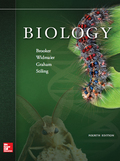
EBK BIOLOGY
4th Edition
ISBN: 8220102797376
Author: BROOKER
Publisher: YUZU
expand_more
expand_more
format_list_bulleted
Question
Chapter 57, Problem 2COQ
Summary Introduction
To describe:
The ways or methods that animals have evolved to protect themselves from predators.
Introduction:
Animals have adapted to various morphological and genetic traits in order to protect themselves from predators. These protection techniques are known as anti-predator techniques. These techniques are developed by animals themselves.
Expert Solution & Answer
Want to see the full answer?
Check out a sample textbook solution
Students have asked these similar questions
Limetown S1E4 Transcript: E
n 2025SP-BIO-111-PSNT1: Natu
X
Natural Selection in insects
X
+
newconnect.mheducation.com/student/todo
CA
NATURAL SELECTION NATURAL SELECTION IN INSECTS (HARDY-WEINBERG LAW)
INTRODUCTION
LABORATORY SIMULATION
A Lab Data
Is this the correct allele frequency?
Is this the correct genotype frequency?
Is this the correct phenotype frequency?
Total
1000
Phenotype Frequency
Typica
Carbonaria
Allele Frequency
9
P
635
823
968
1118
1435
Color
Initial Frequency
Light
0.25
Dark
0.75
Frequency Gs
0.02
Allele
Initial Allele Frequency
Gs Allele Frequency
d
0.50
0
D
0.50
0
Genotype Frequency
Moths
Genotype
Color
Moths
Released
Initial
Frequency
Frequency G5
Number of
Moths Gs
NC
- X
Which of the following is not a sequence-specific DNA binding protein?
1. the catabolite-activated protein
2. the trp repressor protein
3. the flowering locus C protein
4. the flowering locus D protein
5. GAL4
6. all of the above are sequence-specific DNA binding proteins
Which of the following is not a DNA binding protein?
1. the lac repressor protein
2. the catabolite activated protein
3. the trp repressor protein
4. the flowering locus C protein
5. the flowering locus D protein
6. GAL4
7. all of the above are DNA binding proteins
Chapter 57 Solutions
EBK BIOLOGY
Ch. 57.1 - Prob. 1CCCh. 57.1 - Prob. 2CCCh. 57.1 - Prob. 1EQCh. 57.1 - Prob. 2EQCh. 57.1 - Prob. 3EQCh. 57.2 - Prob. 1CCCh. 57.2 - Prob. 2CCCh. 57.2 - (a) A quahog clam, cless Bavalvia (b) A chlton,...Ch. 57.2 - Prob. 3CCCh. 57.2 - Prob. 4CC
Ch. 57.2 - Prob. 2BCCh. 57.2 - Core Skill: Connections More than 4,500 species of...Ch. 57.3 - Prob. 1CCCh. 57.3 - Prob. 1BCCh. 57.3 - Prob. 2BCCh. 57.4 - Prob. 1CCCh. 57 - Prob. 1TYCh. 57 - Prob. 2TYCh. 57 - Prob. 3TYCh. 57 - In Lacks study of passerine birds in Britain,...Ch. 57 - Prob. 5TYCh. 57 - Prob. 6TYCh. 57 - Prob. 7TYCh. 57 - Prob. 8TYCh. 57 - Prob. 9TYCh. 57 - Prob. 10TYCh. 57 - Prob. 1CQCh. 57 - Prob. 2CQCh. 57 - Prob. 1COQCh. 57 - Prob. 2COQCh. 57 - Prob. 3COQ
Knowledge Booster
Similar questions
- What symbolic and cultural behaviors are evident in the archaeological record and associated with Neandertals and anatomically modern humans in Europe beginning around 35,000 yBP (during the Upper Paleolithic)?arrow_forwardDescribe three cranial and postcranial features of Neanderthals skeletons that are likely adaptation to the cold climates of Upper Pleistocene Europe and explain how they are adaptations to a cold climate.arrow_forwardBiology Questionarrow_forward
- ✓ Details Draw a protein that is embedded in a membrane (a transmembrane protein), label the lipid bilayer and the protein. Identify the areas of the lipid bilayer that are hydrophobic and hydrophilic. Draw a membrane with two transporters: a proton pump transporter that uses ATP to generate a proton gradient, and a second transporter that moves glucose by secondary active transport (cartoon-like is ok). It will be important to show protons moving in the correct direction, and that the transporter that is powered by secondary active transport is logically related to the proton pump.arrow_forwarddrawing chemical structure of ATP. please draw in and label whats asked. Thank you.arrow_forwardOutline the negative feedback loop that allows us to maintain a healthy water concentration in our blood. You may use diagram if you wisharrow_forward
- Give examples of fat soluble and non-fat soluble hormonesarrow_forwardJust click view full document and register so you can see the whole document. how do i access this. following from the previous question; https://www.bartleby.com/questions-and-answers/hi-hi-with-this-unit-assessment-psy4406-tp4-report-assessment-material-case-stydu-ms-alecia-moore.-o/5e09906a-5101-4297-a8f7-49449b0bb5a7. on Google this image comes up and i have signed/ payed for the service and unable to access the full document. are you able to copy and past to this response. please see the screenshot from google page. unfortunality its not allowing me attch the image can you please show me the mathmetic calculation/ workout for the reult sectionarrow_forwardIn tabular form, differentiate between reversible and irreversible cell injury.arrow_forward
arrow_back_ios
SEE MORE QUESTIONS
arrow_forward_ios
Recommended textbooks for you
 Biology (MindTap Course List)BiologyISBN:9781337392938Author:Eldra Solomon, Charles Martin, Diana W. Martin, Linda R. BergPublisher:Cengage Learning
Biology (MindTap Course List)BiologyISBN:9781337392938Author:Eldra Solomon, Charles Martin, Diana W. Martin, Linda R. BergPublisher:Cengage Learning Issues and Ethics in the Helping Professions (Min...NursingISBN:9781337406291Author:Gerald Corey, Marianne Schneider Corey, Cindy CoreyPublisher:Cengage Learning
Issues and Ethics in the Helping Professions (Min...NursingISBN:9781337406291Author:Gerald Corey, Marianne Schneider Corey, Cindy CoreyPublisher:Cengage Learning Principles Of Radiographic Imaging: An Art And A ...Health & NutritionISBN:9781337711067Author:Richard R. Carlton, Arlene M. Adler, Vesna BalacPublisher:Cengage Learning
Principles Of Radiographic Imaging: An Art And A ...Health & NutritionISBN:9781337711067Author:Richard R. Carlton, Arlene M. Adler, Vesna BalacPublisher:Cengage Learning

Biology (MindTap Course List)
Biology
ISBN:9781337392938
Author:Eldra Solomon, Charles Martin, Diana W. Martin, Linda R. Berg
Publisher:Cengage Learning


Issues and Ethics in the Helping Professions (Min...
Nursing
ISBN:9781337406291
Author:Gerald Corey, Marianne Schneider Corey, Cindy Corey
Publisher:Cengage Learning


Principles Of Radiographic Imaging: An Art And A ...
Health & Nutrition
ISBN:9781337711067
Author:Richard R. Carlton, Arlene M. Adler, Vesna Balac
Publisher:Cengage Learning
